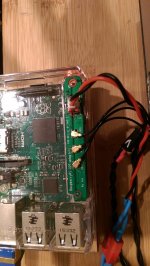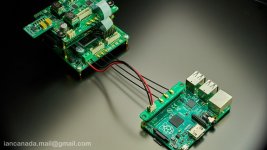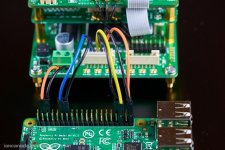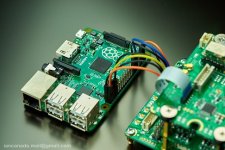I have got my dam1021 module recently . I planning to connect it with rpi. I have googled but not much information on how to implement this. I am a novice in this field. There are some information in some forums, but those are too technical to be understood by a novice. Can someone please clarify followings:
1. Can I connect rpi through i2s interface or I need some SPDIF hat with rpi to connect dam1021. If it can be connected by i2s, is thete any diagram that can guide me. Will that degrade the sound Quality?
2. Will I need any driver for rpi if it is connected by i2s and where can I find that?
3. Is there any step by step guide to connect rpi with dam1021? I can do the rest of the jobs as enough information are there in the web.
1. Can I connect rpi through i2s interface or I need some SPDIF hat with rpi to connect dam1021. If it can be connected by i2s, is thete any diagram that can guide me. Will that degrade the sound Quality?
2. Will I need any driver for rpi if it is connected by i2s and where can I find that?
3. Is there any step by step guide to connect rpi with dam1021? I can do the rest of the jobs as enough information are there in the web.
You can connect directly via I2S - with good result. You need to connect four wires, not longer than max 10 cm between the two units. There you find the pins from the Raspberry to connect. The Raspberry Pi: Audio out through I2S | Dimdim's Blog
In the manual on the homepage from Soekris you will find the pins on the Dac to connect to. Here you also see the important part of feeding with 3.3 volt.
This page might be very helpful, even if it is not mentioning the Pi
Soekris dam 1021 R-2R DAC ILLUSTRATED GUIDE | H i F i D U I N O look for I2S isolated.
You then need to source the pi with software - here are several options, depending on what program you will use. Dietpi might be a good and pretty easy option for setting up the Pi. Volumio (who has a driver for the Soekris), Moode, and several other might also be options.
I have probably forgot something, that I am sure others will contribute with
In the manual on the homepage from Soekris you will find the pins on the Dac to connect to. Here you also see the important part of feeding with 3.3 volt.
This page might be very helpful, even if it is not mentioning the Pi
Soekris dam 1021 R-2R DAC ILLUSTRATED GUIDE | H i F i D U I N O look for I2S isolated.
You then need to source the pi with software - here are several options, depending on what program you will use. Dietpi might be a good and pretty easy option for setting up the Pi. Volumio (who has a driver for the Soekris), Moode, and several other might also be options.
I have probably forgot something, that I am sure others will contribute with
Thanks for your response, let me see and try. Hope it will not be complicated.You need to connect four wires, not longer than max 10 cm between the two units. There you find the pins from the Raspberry to connect. The Raspberry Pi: Audio out through I2S | Dimdim's Blog
In the manual on the homepage from Soekris you will find the pins on the Dac to connect to. Here you also see the important part of feeding with 3.3 volt.
This page might be very helpful, even if it is not mentioning the Pi
Soekris dam 1021 R-2R DAC ILLUSTRATED GUIDE | H i F i D U I N O look for I2S isolated.
You then need to source the pi with software - here are several options, depending on what program you will use. Dietpi might be a good and pretty easy option for setting up the Pi. Volumio, Moode, and several other might also be options.
I have probably forgot something, that I am sure others will contribute with
Have the excact same. digi+ pro - i2s to dam1021. Unsure if it makes a better sound though..Adding a hat between the Pi and the DAC, like the Hifiberry Digi, will improve the I2S signal and thereby the sound quality. I use the Hifiberry Digi+ Pro. Needed to solder on a pin header on to connect the I2S cables; not very difficult.
Why 2 identical threads btw?
Adding a hat between the Pi and the DAC, like the Hifiberry Digi, will improve the I2S signal and thereby the sound quality. I use the Hifiberry Digi+ Pro. Needed to solder on a pin header on to connect the I2S cables; not very difficult.
Thanks, can you please give some reference from where I can get more detail.
Have the excact same. digi+ pro - i2s to dam1021. Unsure if it makes a better sound though..
Why 2 identical threads btw?
!! Don't know!! somehow it has been posted twice, I can't delete another one
Adding a hat between the Pi and the DAC, like the Hifiberry Digi, will improve the I2S signal and thereby the sound quality. I use the Hifiberry Digi+ Pro. Needed to solder on a pin header on to connect the I2S cables; not very difficult.
No, I2S is by far superior if compared with Spdif, that the digi+ pro outputs. If you want to get better quality, use a reclocking HAT like the ones from Iancanada or even the Kali. This will make the sound quality much better than the cheap digi+ pro.
By the way, whats the idea behind using the digi+ and than using the digi+ i2s output? Why? Or do you mean using the digi+ spdif output ? Either way, a reclocker is the way, not the digi+.
Thanks, can you please give some reference from where I can get more detail.
Check this link on how to get I2S output from the Hifiberry Digi+ Pro.
DAC+ Pro - connect external I2S DACs – HiFiBerry
If you want to get better quality, use a reclocking HAT like the ones from Iancanada or even the Kali. This will make the sound quality much better than the cheap digi+ pro.
Reclocking hat before reclocking dac? The more, the merrier?
I also thought that lower incoming jitter would call for less pll hunting in the DAM, only practical tests did not confirm this. No experience with this particular setup though.
I don't think that reclocking is doing a difference, since the DAM is reclocking as just mentioned above - and I think Søren (Soekris) agrees with that - if you go through the long thread about the DAM 1021. But from the difference in responses you can see that within DIY there will be a range of perspectives  Personally I agree with the perspective that I2S is superior, and that there is no need for reclocking in this combination
Personally I agree with the perspective that I2S is superior, and that there is no need for reclocking in this combination
Last edited:
I am using three rpi´s in the house, and have some experience with this. When it comes to sq I cannot tell argue for any difference. But the stability of the signal differs. The Edimax dongle have not proved to be especially stable, so where I need to use wifi, I am now the RPI3, which is more stable, otherwise cable.
I've gotten good results using an isolator board and a Kali between an RPi and a DAM1021 setup.
As someone else said, also consider Ian Canada's soon to be released FIFOPi.
Greg in Mississippi
Can you please give some idea on how did you connect, or a picture/diagram . Thanks
@daniel4381,
I have to say I 'cheated' a bit on the connection to the RPi. Ian Canada made an RPi I2S adapter board that he sold in his last group buy. I expect he'll offer it in his next Group Buy, which should kick off in the next couple of weeks. He lists them in the info for his last group buy in post 2421, item #20, of this thread:
Ian asynchronous I2S and S/PDIF FIFO KIT group buy
Check the last few pages of the thread for information on his latest Group Buy.
I didn't see a picture of it there, so am including a couple here.
I connected the 3 I2S lines to the appropriate I2S input pins of the DAM 1021 J3 header as described on page 7 of the 1021 manual.
So my stack goes RPi ^ IsolatorPi ^ Allo Kali ^ Ian RPi I2S Adapter. Of course, with the Isolator board (Ian's or Allo's) you need at least 2 5V supplies for the stack... one for the RPi, the other for the isolator board / Kali pair. You can use 3 supplies for some additional SQ gains... I do.
You can also connect jumper leads to the appropriate pins on the Kali or even directly on an isolator board or directly on the RPi, for greater simplicity, but reduced SQ. I've also attached pictures showing this.
I hope this provides what you needed.
Greg in Mississippi
I have to say I 'cheated' a bit on the connection to the RPi. Ian Canada made an RPi I2S adapter board that he sold in his last group buy. I expect he'll offer it in his next Group Buy, which should kick off in the next couple of weeks. He lists them in the info for his last group buy in post 2421, item #20, of this thread:
Ian asynchronous I2S and S/PDIF FIFO KIT group buy
Check the last few pages of the thread for information on his latest Group Buy.
I didn't see a picture of it there, so am including a couple here.
I connected the 3 I2S lines to the appropriate I2S input pins of the DAM 1021 J3 header as described on page 7 of the 1021 manual.
So my stack goes RPi ^ IsolatorPi ^ Allo Kali ^ Ian RPi I2S Adapter. Of course, with the Isolator board (Ian's or Allo's) you need at least 2 5V supplies for the stack... one for the RPi, the other for the isolator board / Kali pair. You can use 3 supplies for some additional SQ gains... I do.
You can also connect jumper leads to the appropriate pins on the Kali or even directly on an isolator board or directly on the RPi, for greater simplicity, but reduced SQ. I've also attached pictures showing this.
I hope this provides what you needed.
Greg in Mississippi
Attachments
Last edited:
Thank you so much for your kind respons. It looks complicated for novice like me, but I'll definitely give a try, lets see,@daniel4381,
I have to say I 'cheated' a bit on the connection to the RPi. Ian Canada made an RPi I2S adapter board that he sold in his last group buy. I expect he'll offer it in his next Group Buy, which should kick off in the next couple of weeks. He lists them in the info for his last group buy in post 2421, item #20, of this thread:
Ian asynchronous I2S and S/PDIF FIFO KIT group buy
Check the last few pages of the thread for information on his latest Group Buy.
I didn't see a picture of it there, so am including a couple here.
I connected the 3 I2S lines to the appropriate I2S input pins of the DAM 1021 J3 header as described on page 7 of the 1021 manual.
So my stack goes RPi ^ IsolatorPi ^ Allo Kali ^ Ian RPi I2S Adapter. Of course, with the Isolator board (Ian's or Allo's) you need at least 2 5V supplies for the stack... one for the RPi, the other for the isolator board / Kali pair. You can use 3 supplies for some additional SQ gains... I do.
You can also connect jumper leads to the appropriate pins on the Kali or even directly on an isolator board or directly on the RPi, for greater simplicity, but reduced SQ. I've also attached pictures showing this.
I hope this provides what you needed.
Greg in Mississippi
- Status
- This old topic is closed. If you want to reopen this topic, contact a moderator using the "Report Post" button.
- Home
- Source & Line
- Digital Line Level
- Queries on Soekris DAM1021 module and Raspberry pi.



